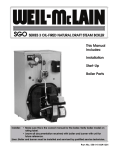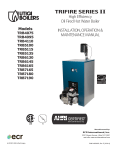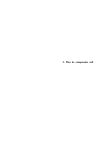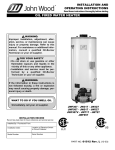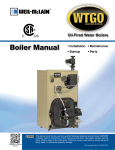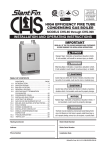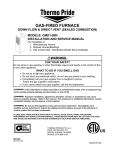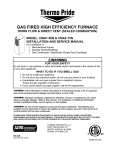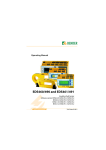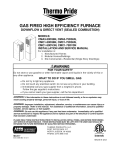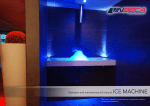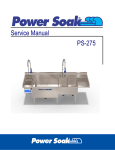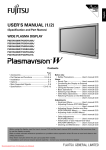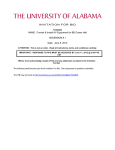Download Oil Furnace Mobile Home (OME)
Transcript
OIL-FIRED FURNACE DOWN FLOW & DIRECT VENT (SEALED COMBUSTION) MODEL: OME-72D36 / OME-72T36 INSTALLATION AND SERVICE MANUAL For installation in: 1. Manufactured Homes 2. Modular Homes/Buildings 3. Site Construction—Residential : FOR YOUR SAFETY Do not store or use gasoline or other flammable vapors and liquids in the vicinity of this or any other appliance. WHAT TO DO IF YOU SMELL GAS • Do not try to light any appliance. • Do not touch any electrical switch; do not use any phone in your building. • Immediately call your gas supplier from a neighbor’s phone. Follow the gas supplier’s instructions. • If you cannot reach your gas supplier, call the fire department. : If the information in these instructions is not followed exactly, a fire or explosion may result causing property damage, personal injury or loss of life. : Improper installation, adjustment, alteration, service, or maintenance can cause injury or property damage. Refer to this manual. For assistance or additional information consult a qualified installer, service agency, or fuel supplier. : Do not use this appliance if any part has been underwater. Immediately call a qualified service technician to inspect the appliance and to replace any part of the electrical or control system that has been underwater. PLEASE READ THESE INSTRUCTIONS PRIOR TO INSTALLATION, INITIAL FIRING, AND BEFORE PERFORMING ANY SERVICE OR MAINTENANCE. THESE INSTRUCTIONS MUST BE LEFT WITH THE USER AND SHOULD BE RETAINED FOR FUTURE REFERENCE BY QUALIFIED SERVICE PERSONNEL. THERMO PRODUCTS, LLC. POST OFFICE BOX 217 NORTH JUDSON, IN 46366 PHONE: (574) 896-2133 MO-487 ECN 5411-MA 150715 MADE IN USA All installations and services must be performed by qualified service personnel. I. SAFETY SECTION This page and the following two pages contain various warnings and cautions found throughout this furnace Service and Installation Manual. Please read and comply with the statements on the cover and the statements below. : All local codes and ordinances must be followed with regard to the oil tank and oil lines. All lines must have shut off valves, use a proper pipe joint compound (specified for use with oil) on all pipe threads, no kinks, no sharp bends, and be properly tested for leaks. Flare fittings are recommended for tubing. : This : DO furnace is not to be used as a construction heater. NOT RUN THE OIL PUMP DRY FOR MORE THAN FIVE MINUTES. : When testing electrical equipment, always follow standard electrical procedures and precautions. : The heat exchanger must be cleaned by a qualified service person. : The area around the furnace should be kept free and clear of combustible materials, especially papers and rags. : NEVER burn garbage or refuse in your furnace. NEVER try to ignite oil or gas by tossing burning papers or other material into your furnace. : Thermo Pride oil furnaces are designed to burn commercial standards of No. 1 and No. 2 fuel oil. NEVER USE GASOLINE OR A MIXTURE OF OIL AND GASOLINE. : Do not attempt to start the burner when: 1. Excess oil has accumulated 2. The furnace is full of vapors or 3. The combustion chamber is very hot. If one or more of these conditions exist, contact a qualified service person. : If the temperature rise exceeds 100°F, the heat exchanger may fail voiding the heat exchanger warranty resulting in property damage, personal injury or loss of life. : Burner adjustments must be confirmed by instrumentation. Failure to use accurate or calibrated instrumentation to setup the burner may result in reduced efficiency, sooting and/or the production of hazardous carbon monoxide gas. : Any attempt to relocate safety controls or replace safety controls with a control that is not approved or incompatible, may result in personal injury, substantial property damage or death. 1 All installations and services must be performed by qualified service personnel. : If you do not follow these instructions exactly, a fire or explosion may result causing personal injury, loss of life or property damage. : NEVER use gasoline or a mixture of oil and gasoline to start the burner or furnace. : HAZARD OF ASPHYXIATION: Negative pressure inside the closet with closet door closed and the furnace blower operating shall be no more negative than minus 0.05 inch water column. : Do not obstruct any return air openings, including the return grille on the furnace. To do so may cause the furnace to activate the high limit and shut down or it may cause asphyxiation. : All local codes and ordinances take precedence with regard to tank and oil lines. All lines must have shutoff valves, a good pipe joint compound approved for use with oil on all pipe threads, no kinks, no sharp bends and be properly tested for leaks. Flare fittings are recommended for tubing. : Do not use motor oil or any fuel heavier than No. 2 fuel oil.. 2 All installations and services must be performed by qualified service personnel. : If you suspect there is a problem with the furnace, the venting system or any other related problem, immediately contact a qualified service agency. If a service agency is not available contact your fuel supplier. : Personal injury, or property damage, could result from major repair or service of this furnace by anyone other than a qualified contractor. Only the routine maintenance described in the user section of this manual should be performed by the user. : The area around the furnace should be kept free and clear of combustible materials, especially papers and rags. : Never burn garbage or refuse in your furnace. Never try to ignite oil or gas by tossing burning papers or other material into your furnace. : Do not attempt to start the burner when: 1. Excess oil or gas has accumulated. 2. The furnace is full of vapors. 4. The combustion chamber is very hot. If one or more of these conditions exist, contact a qualified service person. : Do not block or obstruct air openings on the furnace or air openings communicating with the area in which the furnace is installed. : Do not allow the outside air intake to be blocked or obstructed by vegetation, ice, snow or any other materials. : Do not use this furnace if any part has been underwater. Immediately call a qualified service agency to inspect the furnace and to replace any part of the electrical or control system which has been underwater. : Should overheating occur or the fuel supply fail to shut off, shut off the manual fuel supply valve to the furnace before shutting off the electrical supply. 3 All installations and services must be performed by qualified service personnel. This page and the following page contain reproductions of the various warning and instruction labels placed on the Thermo Pride Oil Furnace. Please read and comply with the contents of these labels. 4 All installations and services must be performed by qualified service personnel. 4a All installations and services must be performed by qualified service personnel. TABLE OF CONTENTS SECTION BEGINNING PAGE I. II. III. IV. SAFETY SECTION GENERAL INSTRUCTIONS AND CLEARANCES FURNACE SPECIFICATIONS INSTALLATION A. ROOF JACK B. STANDARD CHIMNEY C. FURNACE LOCATION D. BASE INSTALLATION 1. Combustible Floor Base Model: 70-BASE 2. Cottage Base Model: 01COT-BASE E. ALCOVE INSTALLATION F. CLOSET INSTALLATION G. COMBUSTION AIR H. FUEL PIPING 1. Oil Tank and Piping J. ELECTRICAL WIRING 1. Electrical Branch Supply Circuit 2. Connection of Power Supply Wires 3. Connection of Thermostat Wires 4. Blower Controller Information for PSC/CTM Motor 5. Wiring Diagram K. BURNER INSTALLATION L. BURNER OPERATION AND ADJUSTMENT M. FLUE GAS COMBUSTION ANALYSIS V. DEALER MAINTENANCE A. TROUBLESHOOTING B. CAD CELL CHECKOUT PROCEDURE C. HEAT EXCHANGER CLEANING INSTRUCTIONS D. CLEANING OR REPLACING FLUE PIPES E. EXTENDED SHUTDOWN AND RESTART VI. USERS INFORMATION SECTION A. WARNINGS & CAUTIONS B. COMPONENT LOCATIONS C. INSPECTION AREAS D. FILTER LOCATION AND CLEANING E. CONTACT INFORMATION APPENDIX A - REPLACEMENT PARTS LIST 5 1 6 8 10 10 10 10 11 11 13 15 15 16 19 19 21 22 22 22 23 30 32 32 35 36 37 42 42 44 44 45 45 46 46 47 47 48 All installations and services must be performed by qualified service personnel. II. GENERAL INSTRUCTIONS AND CLEARANCES NOTE: READ THIS SECTION BEFORE STARTING INSTALLATION 1. The selection of a furnace heating capacity for a proposed installation should be based on a heat loss calculation made according to the manuals provided by the Air Conditioning Contractors of America (ACCA) or the American Society of Heating, Refrigeration and Air Conditioning Engineers, Inc. (ASHRAE). 2. The installer shall be familiar with and comply with all codes and regulations applicable to the installation of this heating appliance. In addition to the governing standards items a) through e) this appliance shall also comply with “CSA B139 for recommended installation practices” where applicable. a. Federal Manufactured Home Constructions & Safety Standard (HUD Total 24, Part 280). b. American National Standard (ANSI-119.2/NFPA-501C), for all recreational vehicle installations. c. American National Standard (ANSI-Z223.1/NFPA-54), for all gas-fired furnaces. d. American National Standard (ANSI-Z95.1/NFPA-31), for all oil-fired furnaces. e. American National Standard Electric Code (ANSI-C1/NFPA-70), for all electrical field wiring. The oil-fired furnace has been investigated under the UL 307A test standard and CSA B140 and is listed by ETL and described as, “For installation as central furnace special type”. : The area around the furnace must be kept free and clear of combustible materials, especially papers and rags. : This furnace is not to be used as a construction heater. 1. Definitions of "combustible" and "non-combustible" materials as presented in the 1996 version of the National Fuel Gas Code, ANSI Z223.1-1996/NFPA 70-1996, are as follows: a. Combustible material: “...materials made of or surfaced with wood, compressed paper, plant fibers, or other materials that are capable of being ignited and burned. Such materials shall be considered combustible even though flameproofed, fireretardant treated, or plastered.” 6 All installations and services must be performed by qualified service personnel. b. Non-combustible material: “...material that is not capable of being ignited and burned; such as material consisting entirely of, or a combination of, steel, iron, brick, concrete, slate, asbestos, glass, and plaster.” This heating appliance must be installed with clearances to combustible material surfaces of not less than the minimum distances given below. Also, allow ample clearances for servicing the furnace for easy access to the air filter, blower assembly, burner assembly, controls, and vent connections. MODELS OME FRONT BACK SIDES ROOF JACK VENT CONNECTOR TOP PLENUM SIDES TOP AND SIDES OF DUCT BOTTOM OF DUCT CLOSET 6” 0” 0” 0” 6” 1” 1” 1” 1” 7 ALCOVE 18” 0” 0” 0” 6” 1” 1” 1” 1” All installations and services must be performed by qualified service personnel. III. FURNACE SPECIFICATIONS MODEL OME-72 Low Fire High Fire1 70,000 85,000 60,000 72,000 HEAT INPUT RATE (BTUH) HEATING CAPACITY (BTUH) BURNER NOZZLE (GPH X ANGLE, HOLLOW CONE) 0.50X80°A OIL PUMP PRESSURE (PSIG) 120 VENT PIPE SIZE (INCHES) 4 DESIGN TEMPERATURE RISE (°F) 66 MINIMUM RETURN AIR TEMP. (°F) 50 SEASONAL EFFICIENCY (AFUE2 *, %) 86 0.60X80°A 1 Burner shipped with 0.60x80°A nozzle *AFUE - INCLUDES STEADY STATE THERMAL EFFICIENCY AND OFF CYCLE LOSSES. 2 ELECTRICAL RATINGS AND SETTINGS: ELECTRICAL SUPPLY: 120 VAC / 60HZ / 1 PHASE MAXIMUM TIME DELAY TYPE FUSE OR HACR BREAKER RATING: 15 AMPS TOTAL RATED CURRENT (AMPS): 10.3 NOMINAL HEAT ANTICIPATOR SETTING -- 0.2 mA DIMENSIONS & WEIGHTS: CABINET: WIDTH - 18 IN., DEPTH – 24-3/4 IN., HEIGHT - 57 IN. NO.70 MOBILE HOME BASE: WIDTH - 18 5/16 IN., DEPTH - 24¼ IN., HEIGHT - 4 IN. WARM AIR DUCT: WIDTH – 12 IN., DEPTH – 12 IN., HEIGHT - 14 ¼ IN. COTTAGE BASE: WIDTH – 18 3/16 IN., DEPTH - 24¼ IN., HEIGHT – 14¾ IN. FILTER QUANTITY & SIZE: (1) @ 18 IN. x 24 IN. x 1 IN. EA. APPROXIMATE SHIPPING WEIGHT: 240 LBS. BURNER DATA OME-72 MANUFACTURER: R.W. BECKETT CORP. MODEL: AFG AIR TUBE LENGTH (IN.): 3 HEAD DESIGN: F-3 REFRACTORY TYPE: ISOFORM (SOFT FIBER) OIL PUMP PRESSURE (P.S.I.G.) 120 8 All installations and services must be performed by qualified service personnel. FOR BURNER COMBUSTION INFORMATION, REFER TO SECTION (M) – FLUE GAS COMBUSTION ANALYSIS. BLOWER DATA FURNACE MODEL BLOWER MODEL MOTOR H.P. NO. OF SPEEDS HIGH SPEED AIRFLOW (SCFM) @ 0.5 IN. W.G. EXTERNAL STATIC PRESSURE DIAMETER X WIDTH OME-72D36 12-9T ½ HP 4 OME-72T36 12-9T ½ HP 5 1195 1189 12 x 9 12 x 9 ALL SPECIFICATIONS ARE SUBJECT TO CHANGE WITHOUT NOTICE. 9 All installations and services must be performed by qualified service personnel. IV. INSTALLATION A. ROOF JACK The roof jack assembly and accessories must be listed by a nationally recognized testing agency for the appropriate fuel. The roof jack assembly must be installed according to the vent manufacturer’s instructions prior to the furnace installation. (Refer to Figure 2 for flue location on furnace.) Adapters for pitched roofs as well as extended barrel length roof jacks are available from Thermo Products. All vent seams and connections must be sealed with high temperature silicone caulk and/or high temperature aluminum tape. B. STANDARD CHIMNEY When installed as a central furnace special type for single story dwelling, venting into a metal vent system approved by a nationally recognized testing agency for the appropriate fuel type is permitted. Lined masonry chimneys are acceptable when sized appropriately. The minimum chimney size should equivalent to the inside free area of the 4-inch diameter vent collar exiting the furnace, or 12.5 square inches. Maximum chimney sizes and acceptable installation practices are referenced in the following publications. In lieu of local codes, when installing the OME-72 with fuel oil, refer to the latest edition of the installation standard NFPA 31, Installation of Oil Burning Equipment. Notice: Blocked Vent Switch Installation for cottage type homes or non-mobile home type dwellings. The blocked vent switch kit must be installed to comply with CAN STD B140.4 where applicable. For installation instructions see AOPS2686 kit. C. FURNACE LOCATION 1. For best performance, locate the furnace so that it is centralized with respect to the duct system. 2. This furnace is only intended for installation with free air return through the furnace door louvers. DO NOT connect a ducted return air system directly to the furnace. Improper installation may create a fire hazard and damage internal equipment, as well as void all manufacturer’s warranties. 3. This furnace may be installed on combustible flooring when utilizing either the No. 70 counterflow floor base, for below the floor duct systems, or with the cottage base, for floor level air distribution. See Figures 1 for depictions of the No. 70 and the cottage bases. 10 All installations and services must be performed by qualified service personnel. 4. This furnace is ETL listed for closet, alcove or freestanding applications. All applications must comply with the requirements of this manual. Combustible Floor Base Model: 70-BASE Figure 1A. Cottage Base Model: 01COT-BASE Figure 1B. D. BASE INSTALLATION 1. Combustible Floor Base Model: 70-BASE 11 All installations and services must be performed by qualified service personnel. Use the base bottom panel as a template to mark floor opening locations (see Figure 2). Cut a square opening in the floor for the supply air connector duct. Cut the opening 1-inch larger than the square template opening. (duct requires 1-inch clearance to combustible floor). Cut a combustion air duct opening in the floor 1/8-inch larger than the template opening. Figure 2. After cutting openings in the floor, place the bottom panel in position. Mark the square opening location on the distribution duct at the connection point of the connector duct. Remove the bottom panel. Cut an opening in the distribution duct slightly larger than the connector duct. (refer to Figure 2 for location of this cut.) Cut the connector duct to length. Install the connector duct. Bend over each tab. Insure an airtight seal by using high temperature sealant or tape on the joint. Reinstall the bottom panel over the connector duct. Insert and secure the combustion air duct. Put the base top assembly in place (see Figure-3). IMPORTANT: A combustion air duct must be used. If the underside of the mobile home is skirted or enclosed (e.g. enclosed in a crawlspace), the combustion air intake should exit through the skirting, or enclosure, if at all possible. All joints and seams of supply ducts and combustion air ducts must be closed with a sealing method suitable to the application conditions and temperatures ( e.g. high temperature silicone caulk and/or aluminum tape). Notice: If desired, combustion air can be brought in thru the roof of the dwelling and into to the furnace cabinet with Thermo Products Kit AOPS7512. See your local Thermo Pride representative for details or call customer service. 12 All installations and services must be performed by qualified service personnel. If the combustion air passageway cannot terminate outside of the skirting or enclosure, a permanent opening with a minimum of 50 square inches of unobstructed infiltration (free area) for ventilation air must be provided for adequate combustion. This permanent opening must be located no less than 12 inches from the bottom of the enclosure or skirting. Figure 3. Slit the corners of connector duct down to the top of the base assembly. If metal projects more than 1-inch above the top of the base assembly, trim the flanges down to 1-inch. While the top of distribution duct is being pulled up with one hand, bend down each side of the connector duct tightly to the base assembly with the other hand. This assures a tight connection between the base assembly and the connector duct and that the distribution duct will be full size. Use high temperature tape and/or high temperature silicone caulking on all joints and seams to minimize air leakage. Secure the base assembly to the floor with two screws in the front flange. 2. Cottage Base Model: 01COT-BASE The 01COT-BASE cottage base (Figure 1B) is required for a freestanding cottage base installation. The cottage base is designed to permit the installation of an 8-inch x 12-inch register in each of the two side panels and the rear panel. This allows combustion air to be drawn from outside, or inside, the structure whichever is appropriate, or permissible. See section G. COMBUSTION AIR for further details regarding combustion air requirements. 13 All installations and services must be performed by qualified service personnel. IMPORTANT: Adequate combustion air must be provided under all circumstances. If the underside of the home is skirted or enclosed (e.g. by an enclosed crawlspace), the combustion air intake should exit through the side of cottage base and terminate outside of the structure. All joints and seams of supply ducts and combustion air ducts must be closed with a sealing method suitable to the application conditions and temperatures (e.g. using high temperature silicone caulk and/or aluminum tape). If the combustion air passageway cannot terminate outside of the structure, a permanent opening with a minimum of 50 square inches of unobstructed infiltration (free area) for ventilation and combustion air must be provided to the interior of the structure. Additional make-up air may need to be supplied to the interior of the structure to compensate for exhaust fans, appliances, or vents which consume air from the interior of the structure. Refer to the assembly installation instructions included with 01COT-BASE cottage base for additional information. 14 All installations and services must be performed by qualified service personnel. E. ALCOVE INSTALLATION In this application, a minimum of 18 inches of clearance must be provided to the front of the unit. Refer to Figure 4. Alcove installations must use the No. 70 mobile home base. Note – access to diagnostic view port. Refer to section G. COMBUSTION AIR for additional combustion air requirements. Figure 4. F. CLOSET INSTALLATION : HAZARD OF ASPHYXIATION: A suction effect will occur when the furnace is operating inside the closet with the closet door closed. For proper operation, the furnace blower shall create no more than a 0.05-inch water column pressure differential between the closet and the adjoining space. Figure 5. 1. The return air opening into the closet is to have a minimum free area of 250 square inches, (refer to Figure 5). 15 All installations and services must be performed by qualified service personnel. 2. The return air opening may be located in the top, the center or (ideally) the bottom of the closet door, or side wall. : Do not obstruct any return air openings, including the return grille on the furnace. To do so may cause the furnace to activate the high temperature limit and shutdown, or it may cause asphyxiation. 3. The cross-sectional area of the return air duct leading into the closet (when located in the floor or ceiling) shall not be less than 250 square inches. 4. The total free area of openings in the floor or ceiling registers serving the return air duct system must be at least 350 square inches. At least one register must be located where it is not likely to be covered by carpeting, boxes, furniture, or any other objects. 5. Materials located in the return duct system must have a flame spread classification of 200 or less. 6. Pans made of a non-combustible material having 1 inch upturned flanges are to be located beneath openings in a floor, return air, duct system. 7. Wiring materials located in the return air duct system must conform to Article 300-22 of the latest edition of the National Electrical Code, NFPA 70. 8. Gas piping shall not be located in, or extend through, the return air duct system. 9. Refer to section G. COMBUSTION AIR for additional combustion air requirements. G. COMBUSTION AIR The furnace requires the proper amount of combustion air be available to combust the fuel cleanly and efficiently. An inadequate combustion air supply can result in unsafe and erratic operation of the burner, sooting of the combustion chamber and the heat exchanger, and possibly, offensive fuel odors. The combustion air intake must provide an adequate source of combustion air to the appliance. Refer to part 5.3 of the National Fuel Gas Code, ANSI Z223.1 / NFPA 541999, or latest edition for application specific combustion air requirements. 16 All installations and services must be performed by qualified service personnel. The preferred location of the outside combustion air intake termination (e.g. an optional stainless steel intake hood, part no.370183) is through the side of the structure, skirting or enclosure. An alternate termination location is under the structure in the skirted or crawlspace area providing a minimum of 50 square inches of free area exists around the perimeter for outside combustion air to be drawn through. NOTE: Combustion air cannot be drawn from the occupied space of the home. The furnace is shipped with a 2” radiator hose, 2” pvc street ell, 3” dia flex hose and clamps. If combustion air needs to be pulled from the floor, attach the black plastic adapter to the base of the combustible floor base. Make sure the knock-out has been removed. Use hi-temperature silicone and screws to secure the adapter. If needed, the combustion air can be pulled from the rear of the floor base. For this method remove the knock out in the vertical wall and attach the adapter to this opening as indicated. The Beckett burner is equipped with a plastic air boot. The 2” radiator hose and 2” pvc street ell are to be attached to the boot inlet. Use the two smaller clamps to affix the hose to the boot and the boot to the male end of elbow. After cutting the flexible hose to the appropriate length, attach it to the street ell and the black adapter using the remaining two clamps. The material recommended for the combustion air duct under the structure is smooth, round, galvanized steel duct or schedule 20 PVC pipe. The maximum duct length allowed is equivalent to 40-feet of straight duct. Reduce this length by 6-feet for the intake hood and each 90-degree elbow used, and by 3-feet for each 45-degree elbow used the combustion air duct. Flexible, spiral, or corrugated duct is not recommended, due to the relatively high pressure drop associated with air movement through this type of passageway. If the combustion air is preferred thru the roof then kit AOPS7512 is required. The radiator hose is then placed over the Beckett boot opening and the hose is clamped over the radiator hose and boot adapter. Attach the other end to the 2-1/2” combustion air pipe that now protrudes out of the lower right separator panel with remaining clamp. An alternate installation method would be to secure the 2” pvc street ell to the metal combustion air pipe. Insert the male end with silicone sealant and then secure with a tek screw. Cut the 3” flex hose to length and attach it with clamp to female end of street ell. Attach the other end to burner air-boot as described earlier. 17 All installations and services must be performed by qualified service personnel. Figure 6. 18 All installations and services must be performed by qualified service personnel. H. FUEL PIPING Sizing and installation of fuel lines must be in accordance with federal, state and local regulations. 1. Oil Tank and Piping All local codes and ordinances take precedence with regard to tank and oil lines. All lines must have oil shutoff valves, a good pipe joint compound approved for use with oil on all pipe threads, no kinks; no sharp bends and be properly tested for leaks. Flare fittings are recommended for tubing. : : Do not run the oil pump dry for more than five minutes. Your furnace is factory equipped to operate on No. 2 distillate fuel (domestic heating) oil. In very cold weather, No. 1 distillate fuel oil may be used. Your oil supplier should be contacted for recommendations. : Do not use motor oil or any fuel heavier than No. 2 fuel oil.. Burners are most commonly installed with a single stage fuel pump (refer to Figure 7). This type of fuel pump, when connected with a supply line only, is satisfactory where the fuel supply is level with, or above, the burner. This type of installation permits gravity flow of oil to the burner. When it is necessary to “lift” (raise) oil to the burner, a return line should be connected between the fuel pump and tank. This requires insertion of the “by-pass” plug into the fuel pump. If the lift exceeds approximately 10 feet, a two-stage pump should be installed with a return line. When a return line is used with either single or two-stage pumps, air is automatically returned to the tank, making the unit self-purging. Use of continuous runs of heavy wall copper tubing is recommended. Always use flare fittings. Avoid use of fittings in inaccessible locations. Avoid running tubing against any type of heating unit and across ceiling or floor joists. If possible, install the tubing under the floor. Specific information on piping, fuel pump connections, lift capabilities and tank installations is provided in the fuel pump manufacturer’s instructions. If the oil tank is located inside the building and the tank capacity is between 10 and 660 gallons, it shall not be located within 5 feet horizontally from any source of heat, or oilburning appliance. Furthermore, the oil tank shall not block access to utility service meters, switch panels, and shutoff valves. If an underground tank used, the top of the tank should be below all piping in order to prevent oil discharge through a broken connection. Underwriters Laboratories requirements now stipulate that all 275 gallon and larger tanks have a bottom outlet. This is to prevent the accumulation of 19 All installations and services must be performed by qualified service personnel. condensate, which causes the tank to rust. It is also recommended to use a water trap or additives to prevent condensate accumulation. If the tank is above the burner, and gravity oil feed to the burner is permitted, a single line system may be used. The line should have a gradual slope downward of approximately 1/2 inch per foot, or more, to a point directly below where it is connected to the pump. Installing the line with a downward slope will help prevent the formation of air pockets in the line. IMPORTANT: An oil safety valve or a delayed-action solenoid valve is required with all gravity feed oil supply systems. IMPORTANT: The oil storage tank must be free of water, sludge and scale to prevent excessive wear and possible damage to furnace oil pump and burner nozzle. A fuel oil filter installed in the oil supply line to the burner is required. OIL FILTER: For all installations, use a low micron, oil filter with the capacity to trap particles 10 microns in diameter, or greater. Filtering the oil supply helps to prevent nozzle clogging. Install the oil filter inside the building between the tank shutoff valve and the burner. The filter cartridge should be replaced at least once a year. The filter body should be thoroughly cleaned before installing a new cartridge. 20 All installations and services must be performed by qualified service personnel. Figure 7. J. ELECTRICAL WIRING All electrical wiring must be installed in strict accordance with local ordinances and codes. In the absence of local ordinances and codes, all electrical wiring must conform to the requirements of the National Electric Code, ANSI/NFPA 70-1999, or latest edition. 21 All installations and services must be performed by qualified service personnel. : When testing electrical equipment, always follow standard electrical procedures and precautions. 1. Electrical Branch Supply Circuit Route all electrical wiring to the left side of the furnace. The power supply circuit to the furnace must be installed and grounded in accordance with the provisions of the National Electrical Code, ANSI/NFPA-70-1999, or latest edition, and all local codes having jurisdiction. Electrical Branch Supply Circuit provisions of the Canadian Electrical Code Part 1 shall be observed and followed where applicable. 2. Connection Of Power Supply Wires a. Remove the furnace control panel cover. b. Insert 120 VAC wires through the strain relief bushing (or conduit connection as applicable) on the left side of the furnace junction box. c. Connect the “Hot” wire to the black wire marked “L1”. d. Connect the “Neutral” wire to the white wire marked “L2”. e. Connect the “ground” wire to the ground lug. 3. Connection Of Thermostat Wires NOTE: Class 1 thermostat wire must be used inside the furnace burner compartment. a. Insert 24 VAC wires through the plastic grommet on the left side of the furnace casing. b. Connect the thermostat wires to “R” and “W” for heating. c. Connect the thermostat wires to the room thermostat. IMPORTANT: The room thermostat should be installed 4 to 5 feet above the floor on interior wall which is relatively free from direct sources of heat (sunlight or supply airflow) or exposure to cold (drafts from open windows and doors). The nominal anticipator setting is 0.2 amperes (refer to the thermostat literature for additional information). Four-conductor thermostat wire is recommended for 24 VAC, low-voltage, control circuit wiring. Only 2 wires are required for the furnace (a heating application only). Electrical Wire Diameter Maximum Recommended Thermostat Wire Length (AWG) (feet) 24 22 20 18 55 90 140 225 22 All installations and services must be performed by qualified service personnel. Once the furnace is installed, check the thermostat heat anticipator the proper nominal setting. a. Connect a multimeter, capable of reading milliamps (mA), in series with the low voltage wires to the thermostat. b. Increase the thermostat setting, or create a “call for heat”. c. Read the value of the thermostat current, in milliamps. d. Adjust the heat anticipator of the thermostat to the value read by the multimeter. If the heat anticipator is set too high, the furnace may delay activation of a heating cycle for too long. If the heat anticipator is set too low, the furnace may cycle too frequently. Either condition may not provide optimal comfort to the homeowner. 4. BLOWER CONTROLLER INFORMATION FOR PSC/CTM MOTOR TERMINAL DEFINITIONS & FIELD WIRING Burner Harness Connector P1 Pin 1- Limit switch connector. Pin 2- 120 VAC Line connection. Pin 3- Burner pilot contact. Pin 4&5120 VAC Neutral connections. Pin 6- Burner pilot contact. Pin 7&8From oil primary control. Pin 9- Limit Switch Input (LSI). Field Wiring to Burner Harness Wires Beckett Connections Pilot (Tstat) Yellow Wires T-T terminals Neutral White White Line Red Black Thermostat / Humidistat connections “C” Common / ground “W” Thermostat call for heat “R” 24 VAC to thermostat “G” Thermostat call for fan “Y” Thermostat call for cool “DEHUM” Humidistat call for dehumidification (TXV systems ONLY) Male quick connect terminals. “S1-3” 120 VAC Hot “N1-7” 120 VAC Neutral “EAC” Electronic Air Cleaner (120 VAC) connection “FAN” Fan On Signal 23 All installations and services must be performed by qualified service personnel. “X” “C” “CC” “CC_COM” “LOW” “HEAT” “COOL” 24 VAC from transformer 24 VAC common from transformer Compressor Contactor Compressor Contactor Common Continuous Blower Speed Blower heat speed tap Blower cool speed tap A. Inputs Power supplies Line voltage is applied between the “S1” and “N1” quick connect terminals. 24 VAC Class II Transformer secondary voltage supplied to X and C Limit switch The 120 VAC optically isolated limit switch input is connected on pin P2-1 & 9. Refer to the Heat Mode section for the control operation. Thermostat call for heat “W” 24 VAC thermostat input. A call for heat is recognized when the thermostat connects “W” to “R”. This input has an indicator LED that will light when the control receives a call for heat. Refer to the Heat Mode section for the control operation. Thermostat call for fan “G” 24 VAC thermostat input. A call for fan is recognized when the thermostat connects “G” to “R”. This input has an indicator LED in that will light when the control receives a call for fan. Refer to the Fan Mode section for the control operation. B. Outputs PSC Control The control shall control a five speed indoor blower motor. Rating shall be 10 FLA, 30 LRA @ 120 VAC. Connections are made via 0.250 x 0.032” male quick connect terminals labeled “HEAT”, “COOL”, and “LOW”. “HEAT” is energized when the heat speed blower is to run. “COOL” is energized when the Cool speed blower is to run. “LOW” is energized during a call for fan is received or a call for dehumidification is received. Oil Burner Control The control provides dedicated contacts to operate the T-T input of an oil primary control. Rating shall be class 2 – 24 VAC pilot duty @ 24 VAC (<200mA). Power The switched 120 VAC power from the LIMIT switch passes through the board between Pins 1 & 2 of connector P1. 24 All installations and services must be performed by qualified service personnel. EAC (electronic air cleaner) The control provides a 120 VAC output for an electronic air cleaner. This output is energized whenever the fan motor is energized (either low, heat or cool speed). Connection is made via male quick connect terminal labeled “EAC”. Humidifier The control provides a 120 VAC output for a humidifier. Connections are made to a male quick connect terminal labeled “FAN”. The control does not switch this output, it provides a pass-through connection from P1-7 from the switched primary voltage of the Burner Module. Status LED A red LED is provided to indicate any thermostat input has been recognized by the microprocessor on the control. See Diagnostic Features for a function description of operation. Thermostat Input LEDs Four green LEDs are placed beneath their respective thermostat connections (W, Y, G and DEHUM) and operate whenever a call is present. See Diagnostic Features for a function description of operation. C. Operating Modes Standby Mode All outputs are off and the control is waiting for a thermostat demand. The thermostat inputs, and limit switch are continuously monitored. The control initiates action when a thermostat call is received or limit switch opens. Fan Mode A call for fan (“G”) is received from the thermostat. If no other mode is calling for blower operation, the control will operate the fan relay (K4) and power the “Low” blower speed terminal. The fan mode will be operated as long as the “G” input is calling and neither the Heat mode nor the Cool mode is calling for blower operation. When the Heat and Cool modes call for blower operation, their respective outputs will take precedence after their respective turn-on time delays have expired. Cooling Mode A call for cool (“Y”) is received from the thermostat. If the heat mode is not active or the anti-short cycle delay is not in effect, the control will energize the “CC” terminal and after a 10 second power demand conservation delay energizes the “COOL” speed blower terminal. When the call for cool is satisfied, the “CC” terminal is de-energized and the cooling off delay of 45 seconds is started. Forty-five seconds later the “COOL” speed blower terminal is de-energized and the control reverts to Standby Mode. Dehumidification Operation If a call for dehumidification is received while the Cool Mode is active, blower speeds will be reduced. The PSC “COOL” blower speed terminal (1158-100 model only) will be de-energized and “Low” blower speed will be energized. Anti-Short Cycle Operation To prevent compressor short cycling, a call for cooling will be ignored for four minutes after the termination of any cooling call. The anti-short cycle delay is also in effect at power-up. 25 All installations and services must be performed by qualified service personnel. Heat Mode When a call for heat (“W”) is received from the thermostat, if the “Cool” mode is not already active, the “TT” terminal is energized and the blower on delay is started. The on-off pattern of DIP switch SW2 (positions 1 and 2) select one of four blower on delay values (see Table 11). When the delay time has elapsed, the “HEAT” blower speed is energized. The control remains in steady heat mode until the thermostat is satisfied. When the call for heat signal is removed, the “T-T” terminal is de-energized and the blower off delay is started. The on-off pattern of DIP switch SW2 (positions 3 and 4) select one of four blower off delay values (see Table 11). When the delay time has elapsed, the “HEAT” blower speed terminal is de-energized. DIP SWITCH 2 SECTION STATE FACTORY SETTING FACTORY SETTING 3 BLOWER DELAY TIMES 1 2 4 ON - SEC OFF OFF 30 ON OFF 60 OFF ON 120 ON ON 240 OFF - MIN OFF OFF 2 ON OFF 4 OFF ON 6 ON ON 8 Table 11: ON and OFF Blower Delay Time Switch Settings Blower On and Off Delays Four Heat blower on and four blower off delays are selected by two dip switches for each function. Refer to Table 11 for specific delay values. 26 All installations and services must be performed by qualified service personnel. OME-72D36 ALTERATIONS REQ’D FOR A/C @ DESIGN EXTERNAL STATIC PRESSURE HTG Speed by Input Recommended CLG COOLING Low Fire High Fire Speed UNIT 24,000 30,000 36,000 Speed Tap\ Static Pressure Low Low Low ML ML ML Med Low Med High High Furnace Airflow (CFM) vs. External Static pressure (in. WC.) 0.1 0.2 0.3 0.4 0.5 0.6 0.7 Low 849 809 768 724 677 627 512 ML 1011 971 923 887 849 776 724 MH 1227 1200 1156 1145 1092 1004 923 High 1492 1443 1397 1354 1295 1195 1092 Blower Motor Current Draw / Power (Amps / Watts) vs. External Static pressure (in. WC.) Low 3.2 / 309 3.2 / 310 3.0 / 297 2.9 / 292 2.8 / 285 2.7 / 280 2.6 / 271 ML 4.0 / 400 4.0 / 394 3.9 / 386 3.7 / 374 3.5 / 364 3.4 / 352 3.3 / 343 MH 4.9 / 508 4.8 / 497 4.6 / 481 4.5 / 472 4.3 / 455 4.0 429 3.8 / 415 High 5.8 / 618 5.7 / 607 5.5 / 586 5.3 / 570 5.2 / 554 4.9 / 532 4.7 / 515 Speed Tap\ Static Pressure 0.1 0.2 Low 80 84 ML 67 70 MH 55 56 High 45 47 High Fire Temperature Rise vs. External Static pressure (in. WC.) 0.3 0.4 0.5 0.6 0.7 88 94 100 108 132 73 76 80 87 94 59 59 62 67 73 48 50 52 57 62 Low Fire Temperature Rise vs. External Static pressure (in. WC.) Speed Tap\ Static Pressure 0.1 0.2 0.3 0.4 0.5 0.6 0.7 Low 66 69 73 77 82 89 109 ML 55 57 60 63 66 72 77 MH 45 46 48 49 51 56 60 High 37 39 40 41 43 47 51 = Recommended operation range 27 All installations and services must be performed by qualified service personnel. OME-72T36 ALTERATIONS REQ’D FOR A/C @ DESIGN EXTERNAL STATIC PRESSURE HTG Speed by Input COOLING UNIT Low fire High Fire Recommended CLG Speed (Color) 24,000 30,000 36,000 Low Low Low Med Med Med Med / ML MH High Furnace Airflow (CFM) vs. External Static pressure (in. WC.) Speed Tap\ Static Pressure 0.1 0.2 0.3 0.4 0.5 0.6 0.7 Low 873 807 746 677 602 531 448 ML 1024 975 916 863 812 739 671 MED 1081 1032 980 931 886 1823 757 MH 1175 1138 1091 1041 991 950 887 High 1360 1320 1279 1233 1189 1148 1107 Motor Current Draw (Amps/Watts) vs. External Static pressure (in. WC.) Low 1.6/111 1.6/116 1.7/121 1.7/126 1.8/130 1.8/135 1.9/141 ML 2.2/166 2.3/172 2.3/178 2.4/183 2.5/189 2.5/195 2.6/200 MED 2.5/193 2.6/200 2.7/206 2.7/212 2.8/217 2.9/224 2.9/230 MH 3.1/246 3.2/250 3.8/257 3.3/263 3.4/269 3.5/275 3.5/282 High 4.4/366 4.5/372 4.5/373 4.6/383 4.7/390 4.7/397 4.8/404 High Fire Temperature Rise vs. External Static pressure (in. WC.) Speed Tap\ Static Pressure 0.1 0.2 0.3 0.4 0.5 0.6 0.7 Low 78 84 91 100 112 128 151 ML 66 69 74 78 83 92 101 MED 63 66 69 73 76 82 89 MH 58 59 62 65 68 71 76 High 50 51 53 55 57 59 61 Low Fire Temperature Rise vs. External Static pressure (in. WC.) Speed Tap\ Static Pressure 0.1 0.2 0.3 0.4 0.5 0.6 0.7 Low 64 69 75 83 93 105 125 ML 55 57 61 65 69 76 83 MED 52 54 57 60 63 68 74 MH 47 49 51 54 56 59 63 High 41 42 44 45 47 49 50 = Recommended operation range 28 All installations and services must be performed by qualified service personnel. TROUBLE SHOOTING DIAGNOSTIC FEATURES The control board is equipped with 4 green Input Status LEDs and 1 red Board Status LED. These are intended to provide a quick view into furnace performance without requiring a voltmeter. The green Input Status LEDs are driven by the “Y”, “W”, “G”, and “DEHUM” inputs and are located directly below those inputs. They will light to indicate the presence of these signals. The red Board Status LED has two functions: It will light when the board recognizes a valid input signal and will stay lit until all valid signals are removed. This is intended to show that the board is functioning and able to respond to input signals. It will flash rapidly while 120VAC is missing from the LIMIT switch. This is intended to give a quick visual indication of the High Limit switch. 29 All installations and services must be performed by qualified service personnel. WIRING DIAGRAM 30 All installations and services must be performed by qualified service personnel. 31 All installations and services must be performed by qualified service personnel. K. BURNER INSTALLATION The burner mounts to the furnace on three mounting bolt studs, located on the burner mounting plate, in the lower portion of the vestibule, directly in front of the heat exchanger. The burner insertion depth has been fixed by the factory for the design-specified, combination of the air tube length and the combustion chamber used with the furnace. The combustion chamber is pre-positioned during the assembly process and held in place by the drum and mounting plate. The burner insertion depth is not field-adjustable. Should access to the chamber be necessary, refer to the exploded diagram, in the back of this manual, to identify replacement parts. To install and ready the burner for firing, follow the steps below for both furnace models. 1. With electrical power connected to the furnace, turn off all electrical power to unit. 2. Remove the front lower access panel. 3. Mount the burner to the furnace. Install the flange gasket over the mounting studs and secure the burner flange to the furnace using hex head machine screw nuts, provided in the Parts Kit. 4. Connect the red and white wires from the burner harness to the black, red and white burner power leads found underneath the primary control. Then connect the two yellow wires to the “T & T” terminals on the front of the primary control. For the oil burner installation only: 5. Determine whether an oil return line is required and connect the fuel oil piping to the burner oil pump through the base of the unit. 6. Turn on electrical power to the furnace. Cause or simulate a “call for heat” to bleed air from the oil line at the oil pump. (Temporarily, connect the two thermostat leads to cause the oil pump to run.) 7. With all oil shutoff valves open, open the air-bleed valve on the oil pump and capture the oil flow in a container until all traces of air in the line are gone. 8. Close the air-bleed valve. Check for and correct any oil leaks. The furnace is now ready for burner adjustment. Refer to the following “BURNER OPERATION AND ADJUSTMENT” section. L. BURNER OPERATION AND ADJUSTMENT : NEVER burn garbage or refuse in the furnace. NEVER try to ignite oil or gas by tossing burning papers or other material into your furnace. : If you do not follow these instructions exactly, a fire or explosion may result causing personal injury, loss of life or property damage. 32 All installations and services must be performed by qualified service personnel. : NEVER use gasoline or a mixture of oil and gasoline to start the burner or furnace. 1. Qualified service personnel must perform the first lighting of the burner. 2. The burner instructions must be read and understood before any attempt is made to light this burner. NOTE: For the sequence of burner operations, see individual burner manual. To successfully service and initially set up this furnace you must use the following instruments: [Items (a)-(d) ... apply to both oil and gas furnaces), item (e) ... applies to gas units only, and items (f)-(h) ... applies to oil units only] a. Carbon dioxide (CO2) or oxygen (O2) analyzer. b. Flue gas thermometer (range 100°F to 1000°F) and temperature-measuring device (range -40°F to 240°F, for return and supply air temperatures). c. Carbon monoxide (CO) detector d. Electrical multimeter e. Liquid, U-tube type manometer or equivalent pressure measuring instrument (range: 0 – 28 in.W.G.) f. Smoke spot tester or equivalent smoke density measuring device g. Oil pressure gauge (range: 0-150 PSIG) h. Vacuum gauge (range: 0-30 in. W.G. vacuum) Turn the main service switch that provides power to the furnace to the “off” position. Set thermostat above room temperature. Open all fuel supply valves. Bleed air out of fuel supply line, if not already completed (for oil, power must be “on” to the burner and the pump must be operating to expel air in the supply line). When ignition is established, if necessary, make a preliminary burner air adjustment to attain a clean combustion flame (one which does not create smoke by eye). The flame may be viewed through the overfire inspection cover (see exploded diagram of replacement parts for location identification). After the furnace is warmed up to a steadystate condition (about 15 minutes), the final burner adjustment should be made using combustion instrumentation for measuring carbon dioxide (CO2) or oxygen (O2), carbon monoxide (CO), smoke, and stack temperature. In order to achieve the most efficient combustion possible, the following steps must be taken. IMPORTANT: To achieve proper combustion and efficiency instruments must be used to secure CO2, O2 and CO readings. 1. CARBON DIOXIDE (CO2) or OXYGEN (O2): Take a CO2 sample from the flue pipe or vent connector at a position close to the furnace. It is possible to achieve relatively high CO2 (or low O2) readings with low stack temperatures to produce maximum 33 All installations and services must be performed by qualified service personnel. combustion efficiency. However, the CO2 and O2 values recommended are slightly less, though this means slightly lower efficiency, to allow the burner to better tolerate adverse operating conditions, such as a cold heat exchanger, downdraft conditions, heating content changes in the fuel. This working tolerance means less service and maintenance during heating seasons as well as a reduced chance of producing carbon monoxide under adverse conditions. 2. CARBON MONOXIDE (CO): As described above, take a flue gas sample from the flue pipe or vent connector at a position close to the furnace. The amount of CO generated by combustion ideally should be zero or only a trace. In all cases, it must be less than 50 PPM. Carbon monoxide is a colorless and odorless gas, but it is toxic compound. The production of significant quantities of CO is a strong indicator of incomplete combustion. Check the fuel supply and the burner for fuel leakage. Check for an inadequate supply of clean air for combustion. Also, check for a restricted or blocked flue, vent, or chimney. 3. SMOKE: (oil burners only) A smoke sample should be drawn from the flue pipe or vent connector at a position close to the furnace. For the greatest efficiency, if the first smoke reading is “0”, close the air shutter on the burner until a trace smoke reading is obtained. 4. FLUE GAS TEMPERATURE: The flue gas temperature will vary to some degree depending on the heating content of the fuel, the amount of combustion air, and airflow across heat exchanger. In general, the lower the stack temperature, the higher the efficiency. However, stack temperatures under 350°F may cause flue gases to condense, which in turn may cause excessive metal corrosion. 5. TEMPERATURE RISE: Supply air temperature (measured twelve inches into trunk, away from radiant heat from the furnace) minus (-) return air temperature, or Temperature rise = Supply air temperature - Return air temperature. The temperature rise across the furnace heat exchanger operating at steady-state conditions (about 15 to 20 minutes) should not exceed 100°F. The normal comfort range is between 70°F to 100°F. A lower temperature rise usually results in a higher system efficiency. : If the temperature rise exceeds 100°F, the heat exchanger may fail, voiding the heat exchanger warranty resulting in property damage, personal injury or loss of life. M. FLUE GAS COMBUSTION ANALYSIS : Burner adjustments must be confirmed by instrumentation. Failure to use accurate or calibrated instrumentation to correctly setup the burner may result in reduced efficiency, sooting, and/or the production of hazardous carbon monoxide gas. 34 All installations and services must be performed by qualified service personnel. For typical burner combustion analysis results, refer to the table below. BURNER COMBUSTION PARAMETERS FURNACE MODEL OME-72 LOW-FIRE HIGH-FIRE FUEL TYPE #1 OR #2 FUEL OIL #1 OR #2 FUEL OIL CO (CARBON MONOXIDE) 50PPM OR LESS 50PPM OR LESS CO2 (CARBON DIOXIDE) 10.5-11% 11-12% O2 (OXYGEN) 4.5-6% 4.5-6% SMOKE SPOT RATING 0 0 AIR SHUTTER ADJUSTMENT OPEN TO POSITION 3.5 OPEN TO POSITION 3.5 35 All installations and services must be performed by qualified service personnel. V. DEALER MAINTENANCE THIS SECTION IS ONLY TO BE PERFORMED BY TRAINED, QUALIFIED SERVICE PERSONNEL, AND NOT BY THE FURNACE OWNER. A. TROUBLESHOOTING Note: Check diagnostic code through view port prior to removing doors. : When testing electrical equipment, always follow standard electrical procedures and precautions. 1. Check for line voltage (110-120VAC) to the furnace. If there is no line voltage applied to the furnace, check that disconnecting switch is “on”, fuses or circuit breakers have not blown or tripped. 2. Make sure thermostat is “calling for heat”. 3. Check for adequate fuel supply and pressure. Are all the fuel shutoff valves are open? 36 All installations and services must be performed by qualified service personnel. TROUBLESHOOTING FLOWCHART Set thermostat subbase to "HEAT" Does thermostat make contact? Note: Check diagnostic code through view port prior to removing doors. No Is room temperature above 90 deg. F? Yes Wait for room air to cool. No Yes Yes Is room temperature above thermostat setting? Turn thermostat setting above room temp. No Replace thermostat Does a "call for heat" initiate an ignition cycle? Yes No Is the power switch "off"? Turn power switch "on". No Is there 120 VAC across lines L1 & L2? No Check input power. Reset circiut breaker, or replace blown fuse in disconnected switch. Yes Yes Is the oil primary control receiving 120 VAC? No Have either of the high limit thermostats activated? Yes Yes No With power on,measure voltage across the aux. high limit thermostat N.C. contact to L2. If not 120 VAC, replace aux. high limit thermostat. Else,replace high limit thermostat. 37 Wait for furnace to cool. Look for cause(s) of high limit activation,eg. low airflow, over-firing, blocked flue,etc.. Correct any abnormal conditions. All installations and services must be performed by qualified service personnel. Are the thermostat wires connected properly? No Correct wire connections. Yes Yes Is the oil primary control supplying 24 VAC to the thermostat? Yes Replace thermostat. No Try resetting the oil primary control. Replace the oil primary control, if necessary. Is there combustion airflow to the furnace? No Is there 120 VAC across the burner motor? Yes Is the blower impeller spinning? If so, check for blockages in or a collapsed air duct. Is the air boot shutter open adequately. Yes Yes Check wiring to burner motor. If okay, replace burner motor. 38 No Is the oil primary control receiving power? Reset primary control. If resetting the primary does not work, replace control. All installations and services must be performed by qualified service personnel. After pre-purge, does the oil primary produce a spark at the ignition electrodes? No No Is there 120 VAC across the ignition transformer? Try resetting the oil primary control by depressing the RESET button. Check cad cell function. If all else fails, replace the oil primary. Yes Yes Check wiring to the ignition transformer and the electrodes. Also, check ignition electrode gap. Reset if necessary. Replace electrodes or ignition transformer. While ignition electrodes are sparking does fuel valve open? No Does the oil solenoid valve have 120 VAC across it during the ignition attempt? Yes Yes Check wiring to fuel valve. If valve does not open, replace fuel valve. 39 No Try resetting the oil primary control by depressing the RESET button. If this does not work, replace the oil primary. All installations and services must be performed by qualified service personnel. No After fuel valve opens, does the burner ignite? No Check the fuel supply. Open all manual shutoff valves serving the unit. Purge any air in the fuel line. Is oil present in the fuel line at the valve? Yes No Are the ignition electrodes positioned correctly? Reposition to correct location. Yes Yes Check for blocked or severely worn burner nozzle. Clean or replace as required. Yes Does the burner stay lit past proof of flame check? No Is the oil tank full of fuel? Is the fuel clean without contaminates? Is the fuel filter dirty? Add or replace fuel and fuel filter. Also, check cad cell for proper operation. No Yes Does the fan timer energize the circulating air blower after the 56 second time delay? No Check settings on fan timer against those on connection diagram. Is blower still inoperable after time delay with fan timer set correctly? Yes Measure voltage on the circulating air blower terminals. Is it 120 VAC? No Check wiring to blower. If okay, set fan selector switch to manual. If fan operates, replace fan timer. Yes Does blower wheel spin freely? No Yes Yes (PSC motor only) Is blower motor capacitor functioning properly? Yes Replace motor 40 No Check for blower wheel rubing against housing or motor shaft spinning freely. Adjust or replace as necessary. Replace blower motor capacitor. All installations and services must be performed by qualified service personnel. Yes Does system run until thermostat is satisfied? No Has the high limit thermostat or auxiliary high limit thermostat activated? No Check all wiring for loose connections. Yes Check for reduced airflow through the furnace. This may be caused by an excessively restrictive duct system, an inadequate amount of supply air,especially for furnaces installed in closets, or extremely dirty air filters. Also, check and confirm heat input rate to unit is within specifications. Yes Does burner shut off when thermostat is satisfied? No Check for short in wire to thermostat. Replace thermostat, if necessary. Yes Does the circulating air blower turn off after thermostat is satisfied within 4 minutes? No Check fan timer settings against those on connection diagram. Is fan selector switch set on "manual". Reset if necessary. Does fan still fail to turn off? Yes Troubleshooting Complete. 41 Yes Replace fan timer. All installations and services must be performed by qualified service personnel. B. CAD CELL CHECKOUT PROCEDURE: 1. Remove cad cell lead wires, then start the burner. Shortly after burner starts, place a temporary jumper between terminals f & f of the oil primary control. Connect ohmmeter across cad cell lead wires - resistance should be less than 1600 ohms. 2. Stop the burner and remove temporary jumper. 3. With the burner off, check dark cell resistance across cad cell lead wires. Resistance should be greater than 20,000 ohms. If cell resistances are different from above, recheck wiring, location of cell, etc. If necessary, replace plug in portion of cell, (Part No. 350104). 4. Reconnect cad cell lead wires. Check out the oil primary control according to the instructions packed with the control. C. HEAT EXCHANGER CLEANING INSTRUCTIONS : The heat exchanger must be cleaned by a qualified service person. For oil-fired units, it is important to inspect and clean the heat exchanger once a year, or as necessary, to remove any build-up of soot. A layer of soot on the inside of the heat exchanger will act as an insulator, reducing heat transfer, resulting in reduced efficiency To clean the heat exchanger, 1. First, turn off all power to the unit. 2. Remove cleanout plugs, the vent connector pipe to the chimney, the burner and the burner mounting plate. 3. With access to the inside of the heat exchanger through the burner cleanout openings and the vent pipe connection, it is now possible to use a long, flexible wire brush and an industrial-type vacuum cleaner to remove any soot build-up. NOTE: A one inch (outside diameter) vacuum cleaner hose will fit into the radiator. 42 All installations and services must be performed by qualified service personnel. To vacuum and brush the outer radiator of the heat exchanger, go through the cleanout openings in both directions, as shown in Figure 8. Figure 8. Reassemble the furnace to the original factory-built condition. Remount the burner, being certain that the air tube is properly inserted into the chamber opening. If heavy soot deposits were found in the heat exchanger, this indicates that the burner may be out of adjustment. Reset the burner, as indicated under the “BURNER OPERATION AND ADJUSTMENT”, SECTION L. : Do not start burner unless blower door is secured in place. 43 All installations and services must be performed by qualified service personnel. D. CLEANING OR REPLACING FLUE PIPES Flue pipes should be inspected during the annual maintenance check-up or during each subsequent service call. Check all flue pipes for restrictions due to soot, or carbon build-up, as well as foreign matter, or any materials, that cause the venting system to restrict the proper venting of combustion products. If a restriction is found, the flue pipe must be cleaned or replaced to ensure proper venting. Flue pipes should also be inspected for any signs of corrosion, deterioration or leakage that may cause combustion by-products to infiltrate the home or indoor environment. If signs of corrosion, deterioration or leakage are evident, the flue pipe must be replaced with a properly sized, agency-approved, flue pipe. E. EXTENDED SHUTDOWN If this furnace is shut down or off for an extended period of time, several steps can be taken to help insure a smooth and reliable start. ON SHUT DOWN: 1. 2. 3. 4. Close the fuel supply shutoff valve(s). Turn the furnace power switch “off” and disconnect electrical power to the unit. Fill the oil tank to prevent condensation (oil units only). If shutdown exceeds one season, an oil stabilizer should be added to the oil tank as recommended by your oil supplier (oil units only). ON START-UP: 1. 2. 3. 4. 5. Have the heating system (and furnace) inspected and started by a qualified service person. Check for a clean, adequate supply of fuel. Set the room thermostat above room temperature. Open all shutoff valves in the fuel supply line. Turn “on” the main power at the disconnecting switch and at the furnace power switch to start the burner. If the burner does not start, immediately reset the burner primary (ignition) control module. On oil furnaces, if required, vent the fuel of air as soon as the burner motor starts. If the burner stops during venting, wait three to five minutes before attempting to restart. 44 All installations and services must be performed by qualified service personnel. : Do not attempt to start burner when excess fuel has accumulated inside the furnace. 6. Follow the “BURNER OPERATION AND ADJUSTMENT” procedure in Section L. VI. USER INFORMATION SECTION A. WARNINGS AND CAUTIONS: : If you suspect there is a problem with the furnace, pertaining to the venting system or any other related problem, immediately contact a qualified service agency. If a service agency is not available, contact your fuel supplier. : Personal injury or property damage could result from major repair or service of this furnace by anyone other than a qualified contractor. The user should only perform the routine maintenance described in the user section of this manual. : The area around the furnace should be kept free and clear of combustible materials, especially papers and rags. : Never burn garbage or refuse in your furnace. Never try to ignite oil or gas by tossing burning papers or other material into the furnace. : Do not attempt to start the burner when: 1. Excess oil or gas has accumulated, 2. The furnace is full of vapors, 3. The combustion chamber is very hot. If one or more of these conditions exist, contact a qualified service person. : Do not block or obstruct air openings on the furnace casing. Do not block or obstruct air openings communicating within the area in which the furnace is installed. : Do not allow the outside air intake to be blocked or obstructed by vegetation, ice, snow, or any other materials. : Do not use this furnace if any part has been underwater. Immediately call a qualified service agency to inspect the furnace and to replace any part of the electrical or control system which has been underwater. : Should overheating occur or the fuel supply fail to shut off, shut off the manual fuel supply valve to the furnace before shutting off the electrical supply. Should the furnace not operate – note diagnostic code through view port prior to removing doors. 45 All installations and services must be performed by qualified service personnel. B. COMPONENT LOCATIONS The following diagram shows a typical furnace installation and typical position of the components referenced in these instructions. Figure 9. C. INSPECTION AREAS IMPORTANT: For safe operation it is the responsibility of the owner and/or user that the burner, chimney/vent pipe, heat exchanger and controls should be inspected every year by a qualified heating contractor. 1. VESTIBULE: The furnace vestibule areas or burner compartment should be inspected by opening the lower front door of the furnace and looking for signs of excessive heat such as discoloration of components, materials damaged from rust or corrosion, soot or carbon build-up. 46 All installations and services must be performed by qualified service personnel. 2. EXTERIOR OF FURNACES: The furnace exterior should be inspected for signs of excessive heat such as discoloration of materials or damage from rust or corrosion. 3. VENT CONNECTOR: The furnace vent pipe should be inspected for signs of rust, corrosion pitting, or holes in the pipe. Check for leakage around seams in pipe indicated by soot or condensate streaks. 4. ROOF JACKS: The furnace roof jack should be inspected for signs of rust or corrosion, pitting or holes, signs of excessive condensation or moisture leaking from roof jack. D. FILTER LOCATION AND CLEANING The air filter should be inspected each month and cleaned when dirty. Cleaning the air filter frequently may prevent airborne contaminants from going through the furnace and depositing in the furnace, duct system and interior of the building. See Figure 9, in this section, for the location of the return air filter. E. CONTACT INFORMATION: INSTALLATION / SERVICE Installed by: ________________________________________________ Date Installed: ________________________________________________ Contact Information: ________________________________________________ ________________________________________________ ________________________________________________ ________________________________________________ 47 All installations and services must be performed by qualified service personnel. OIL NOZZLES VESTIBULE HARNESS POWER HARNESS BLOWER SUB-ASSEMBLY (OME-72D36 SHOWN) AUX LIMIT (NOT SHOWN) ITEMS NOT SHOWN APPENDIX A. REPLACEMENT PARTS LIST 48 All installations and services must be performed by qualified service personnel. 49 All installations and services must be performed by qualified service personnel. 50




















































